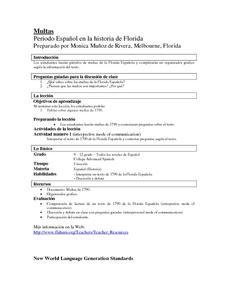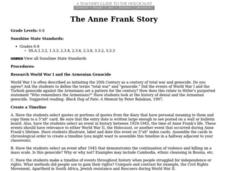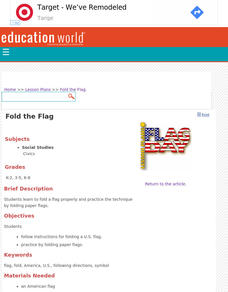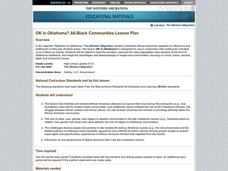Curated OER
Multas
Combine history and Spanish instruction with an exploration of descriptions of fines given in Florida in 1790. Partners read the brief text, fill out a graphic organizer about the crimes described, and interview each other about fines....
Curated OER
The Anne Frank Story
What is genocide? Create timelines regarding the human genocide. Middle and high schoolers analyze information that requires them to consider links between Armenian genocide and the Holocaust. In groups, theydesign timelines that...
Curated OER
Asia and The Middle East quiz 1
In this Asia and The Middle East learning exercise, learners answer history and geography questions about Asia and the Middle East. Students answer 10 short answer questions.
Curated OER
Fold the Flag
Students follow directions to fold a flag properly. They practice on paper flags first and then use a real United States flag. They also examine the history of the flag.
Curated OER
Pennsylvania Firsts Challenge
In this Pennsylvania worksheet, students answer multiple choice questions about history of Pennsylvania's firsts. Students answer 10 questions.
Curated OER
Pennsylvania Firsts Crossword Puzzle
In this Pennsylvania worksheet, students answer questions in a crossword representing Pennsylvania's history of firsts. Students answer 10 questions.
Curated OER
London Quiz 1
In this London worksheet, students answer short answer questions about the history and geography of London. Students complete 20 short answer questions.
Civil Rights Movement Veterans
Timeline of Events: 1960’s Civil Rights Movement of St. Augustine, Florida
A timeline can be a powerful learning tool because it reveals a pattern in events. While few would consider St. Augustine, Florida a hotbed of the 1960s Civil Rights Movement, a selection of background information and a timeline of...
Stanford University
Lesson Plan: The Children's Crusade and the Role of Youth in the African American Freedom Struggle
Young people played significant roles in the Civil Rights movement. Class members examine the contributions of Barbara Johns, Claudette Colvin, Mary Louise Smith, and the children of Birmingham,...
Digital Public Library of America
The Watsons Go To Birmingham—1963 by Christopher Paul Curtis
A primary source set of photographs, videos, newspaper articles, and FBI reports provides insight into race relations during the 1960s, the Sixteenth Street Baptist Church bombing, and the murder of Emmitt Till. Designed to be used to...
Judicial Learning Center
Your 1st Amendment Rights
Why should classes care about the First Amendment? An engaging lesson serves as a powerful tool for answering just that. As all four cases in the lesson relate directly to freedom of expression in schools, young scholars explore the...
Curated OER
We Have a Dream
Students work as partners to study Dr. Martin Luther King's 'I Have a Dream' speech. In this African American history lesson, students work with their cross-grade partner to study, understand, and memorize the speech. Students meet with...
Curated OER
The Harlem Renaissance: Black American Traditions
Students examine the time period of the Harlem Renaissance. As a class, they are introduced to five artists and discuss their art and techniques. Using the internet, they also research the philosophers of the time period and how...
Curated OER
Use of John Johnson's Life Story in Conjunction With Other Black Entrepreneurs as Role Models for Potential Black Businessmen
Learners read an autobiography of John Johnson and discuss how he rose from poverty to be a successful businessman. After reading excerpts of other autobiographies, they brainstorm a list of characteristics of those who were successful...
Curated OER
Loyalists and Loyalism in the American Revolution
Students engage in activities to understand how ideologies were constructed before and during the Revolutionary War. How and why were some "reluctant revolutionaries" turned into whig patriots willing to fight against the British empire,...
Curated OER
Upper class black society during Jim Crow
Students investigate upper class black society during the Jim Crow era by reading primary resources (newspaper articles, census data, photographs). They summarize and organize information on specific citizens in chart form.
Curated OER
Colored Pencil Repoussé
Artists employ a basic metalworking technique by embossing lines and textures into a soft metal. They look for examples of embossed metals in historical and contemporary examples. This fascinating process has been used by many cultures...
Curated OER
Famous Firsts Challenge
For this Black history month worksheet, students read the statements about Black history month. Students select the best answer to complete the 10 statements.
Curated OER
Creating Stories Using Pictographs
Fourth graders research pictograph stories written by Native Americans. They investigate the history behind pictographs, and look through a reference book identifying the different pictures. The teacher then create their own individual...
Curated OER
The Student Non-Violent Coordinating Committee
Pupils identify and analyze the motivation behind the African-American students in organizing the sit-in if Greensboro and the formation of the SNCC. Pupils identify how the generational differences between members of SNCC and other...
Curated OER
Holiday Timeline
Students create a timeline to represent state and national holidays. In this social studies lesson, students use colored popsicle sticks along a line drawn on a piece of paper to illustrate when holidays occur.
Curated OER
Masks
Learners create weather masks. In this social studies activity, students discover the history behind the weather masks used by Native American cultures and then create their own.
Curated OER
OK in Oklahoma? All-Black Communities
Young scholars read a narrative on western migration. They examine the early segregation laws adopted at the time of Oklahoma statehood, and weigh the advantages and disadvantages of single-race communities.
Curated OER
The Homefront: America and WWII
Learners are introduced to the experiences of various groups of Americans at home during WWII, highlighting race, gender, and ethnicity. They improve their ability to analyze and interpret historical documents and images.























